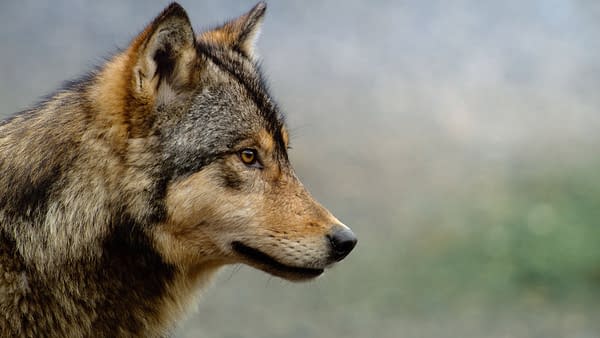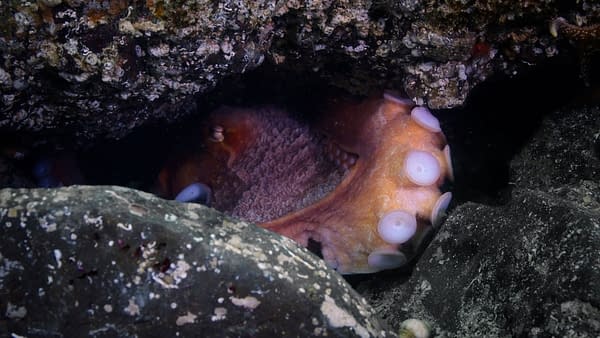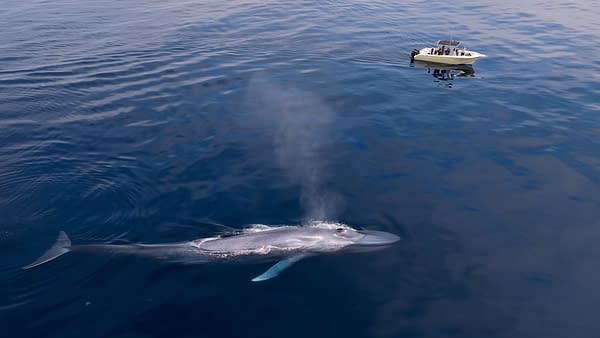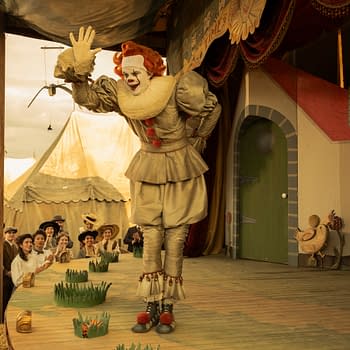Posted in: NBC, Peacock, TV | Tagged: the americas
The Americas: Check Out Our Episode 9: "The West Coast" Preview
With the next chapter hitting tonight, here's a look at our preview for NBC's Tom Hanks-narrated The Americas Episode 9: "The West Coast."
Narrated by Tom Hanks and with music by Oscar and Grammy Award-winning composer Hans Zimmer, NBC's The Americas highlights the world's great supercontinent. Continuing tonight with its ninth chapter, the stunning 10-part event series showcases the wonders, secrets, and fragilities of the world's great supercontinent. For the first time, the Americas stars in its own incomparable series, using cutting-edge technology to uncover never-before-seen behavior and highlight the extraordinary, untold wildlife stories that will deeply connect with millions around the world.
Five years in the making and filmed over 180 expeditions, this groundbreaking series reveals the spectacular landscapes of Earth's most varied landmass – the only one to stretch between both poles. NBC's The Americas' unprecedented scale and ambition delivers remarkable world firsts: new species, new intimate courtship, dramatic deep-sea hunting, and some of nature's strangest stories – even a frog that seems to defy death every day. With the ninth episode hitting tonight, we've got a look at the official overview, image gallery, and sneak preview for "The West Coast" – followed by a look behind the scenes at last week's adventure with Hanks, "The Caribbean."

The Americas: A Look at Episode 9: "The West Coast"
The Americas Season 1 Episode 9: "The West Coast" – The West Coast, where wolves scour shorelines, sea otters dive through the surf, blue whales race and roll in a rare display, and octopuses make the ultimate sacrifice for their young, high in the Redwoods, salamanders leap to survive.
- "The West Coast" Episode 109 — Pictured: Sea otter, Monterey Bay, California — (Photo by: BBC Studios)
- "The West Coast" Episode 109 — Pictured: Aerial British Columbia coastal estuary — (Photo by: BBC Studios)
- "The West Coast" Episode 109 — Pictured: Wandering salamanders breathe through their skin, which must be kept moist — (Photo by: BBC Studios)
- "The West Coast" Episode 109 — Pictured: Coastal wolves specialize in foraging for seafood at low tide, British Columbia, Canada — (Photo by: BBC Studios)
- "The West Coast" Episode 109 — Pictured: Wandering salamander high in the branches of a redwood tree, Norther California — (Photo by: BBC Studios)
- "The West Coast" Episode 109 — Pictured: A female coastal wolf feeds on a washed up humpback whale carcass, British Columbia, Canada — (Photo by: BBC Studios)
- "The West Coast" Episode 109 — Pictured: Male coastal wolf howling, British Columbia, Canada — (Photo by: BBC Studios)
- "The West Coast" Episode 109 — Pictured: Female coastal wolf, British Columbia, Canada — (Photo by: BBC Studios)
- "The West Coast" Episode 109 — Pictured: Wandering salamanders will fearlessly leap from branches, sometimes hundreds of feet in the air, landing unhurt — (Photo by: BBC Studios)
- "The West Coast" Episode 109 — Pictured: Wandering salamanders leap from branches high in the air, stretching out their tails and feet in a position resembling a skydiver — (Photo by: BBC Studios)
- "The West Coast" Episode 109 — Pictured: Sea otter, Monterey Bay, California — (Photo by: BBC Studios)
- "The West Coast" Episode 109 — Pictured: Giant Pacific octopus male in search of a mate. The largest of the octopuses, they can be 16ft across — (Photo by: BBC Studios)
- "The West Coast" Episode 109 — Pictured: California sea lion mother and pup, Point Bennet on San Miguel Island, California — (Photo by: BBC Studios)
- "The West Coast" Episode 109 — Pictured: Giant Pacific octopus female gently brushing her eggs to keep them clean. — (Photo by: BBC Studios)
- "The West Coast" Episode 109 — Pictured: Giant Pacific octopus female walling herself into her den to protect her eggs – up to 100,000 of them — (Photo by: BBC Studios)
- "The West Coast" Episode 109 — Pictured: Giant Pacific octopus female walling herself into her den to protect her eggs — (Photo by: BBC Studios)
- "The West Coast" Episode 109 — Pictured: Point Bennet on San Miguel Island, California, hosts the largest gathering of sealions and seals on Earth – 120,000 of them — (Photo by: BBC Studios)
- "The West Coast" Episode 109 — Pictured: California sea lion feeding at an anchovy 'bait ball' — (Photo by: BBC Studios)
- "The West Coast" Episode 109 — Pictured: Giant Pacific octopus eggs starting to hatch. The octopus babies are no larger than a grain of rice — (Photo by: BBC Studios)
- "The West Coast" Episode 109 — Pictured: At 100ft long or more, a blue whale off the coast of California makes a boat look like a toy — (Photo by: BBC Studios)
- "The West Coast" Episode 109 — Pictured: In the depths of Monterey Canyon, a barreleye fish gazes upwards through its own transparent head to pick out the faint silhouette of any prey above — (Photo by: BBC Studios)
- "The West Coast" Episode 109 — Pictured: For a hundred-ton blue whale to 'breach' takes tremedous power. It may be a male trying to impress a female, California coastal waters — (Photo by: BBC Studios)
- "The West Coast" Episode 109 — Pictured: Blue Whales racing and rolling at up to 30mph off the California coast. Scientists belive this rarely seen behaviour may be a coutship 'heat run' — (Photo by: BBC Studios)
- "The West Coast" Episode 109 — Pictured: Blue Whale mother and calf migrating through Californian coastal waters. The calf puts on a staggering two hundred and fifty pounds a day — (Photo by: BBC Studios)
- "The West Coast" Episode 109 — Pictured: Blue Whale, Monterey Bay, California — (Photo by: Chase Dekker / Minden / naturepl.com / BBC Studios)
- "The West Coast" Episode 109 — Pictured: Extremely rare sighting of a group of blue whales, Santa Barbara Channel, California — (Photo by: Flip Nicklin / Minden / naturepl.com / BBC Studios)
- "The West Coast" Episode 109 — Pictured: Pacific Giant Octopus eggs and newborn, Victoria, British Columbia, Canada — (Photo by: Fred Bavendam / Minden / naturepl.com / BBC Studios)
- "The West Coast" Episode 109 — Pictured: In the depths of Monterey Canyon, a giant Larvacean – just three inches long – secretes two strange structures from its head every day – both made of mucus — (Photo by: BBC Studios)
- "The West Coast" Episode 109 — Pictured: Coastal Grey alpha female in the intertidal zone, Vancouver Island, British Columbia, Canada — (Photo by: Connor Stefanison / naturepl.com / BBC Studios)
- "The West Coast" Episode 109 — Pictured: Californian Sealion territorial bull sleeping amongst his females and pups, San Miguel Island, California, USA. — (Photo by: Suzi Eszterhas / naturepl.com / BBC Studios)
- "The West Coast" Episode 109 — Pictured: Coast Redwood trees in fog, Humboldt Redwoods State Park, California — (Photo by: Yva Momatiuk & John Eastcott / Minden / naturepl.com / BBC Studios)
- "The West Coast" Episode 109 — Pictured: Giant Pacific Octopus, British Columbia, Canada, Pacific Ocean — (Photo by: Brandon Cole / naturepl.com / BBC Studios)
- "The West Coast" Episode 109 — Pictured: Wandering salamander in a redwood forest, Northern California. — (Photo by: Chris Kidd / BBC Studios)
- "The West Coast" Episode 109 — Pictured: Sea otter mother and pup, Monterey Bay, California — (Photo by: Chris Kidd / BBC Studios)
- "The West Coast" Episode 109 — Pictured: Coastal wolves specialize in foraging for seafood at low tide, British Columbia, Canada — (Photo by: Uri Golman / naturepl.com / BBC Studios)
NBC's The Americas is executive produced by renowned Emmy and BAFTA Award-winning wildlife producer Mike Gunton (Life, Planet Earth II, Dynasties) for BBC Studios Natural History Unit, the best-known and most respected producers of natural history content in the world, in association with Universal Television Alternative Studio, a division of Universal Studio Group.
NBC's The Making of "The Americas" is a behind-the-scenes look at how the epic televised adventure came to life that's set to air on Sunday, April 20th at 8 pm ET/PT. Hanks and the crew will reveal perils and breakthroughs behind the lens of this milestone nature series — trekking through corrosive waters 14,000 feet up in the Andes to film flamingos, weathering Amazonian lightning storms, forging bonds between a wild puma and its longtime cameraman, and pioneering cinematography from cameras mounted on the back of a whale. The special will explore the dedication, fieldcraft, humor, heart, and innovation that came together to create one of the most ambitious wildlife series ever produced














































